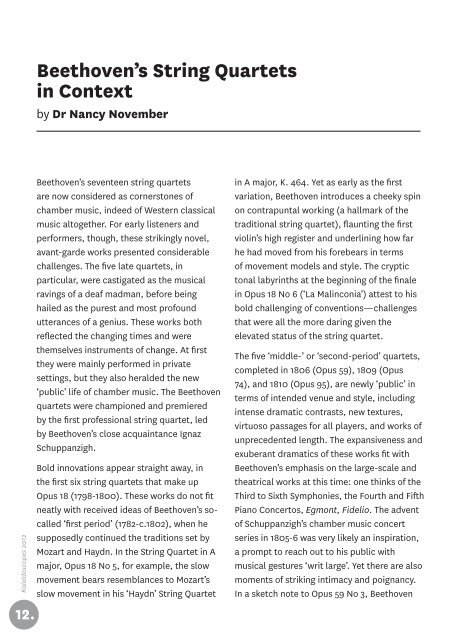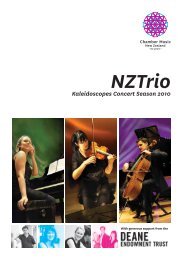BEETHOVEN! - Chamber Music New Zealand
BEETHOVEN! - Chamber Music New Zealand
BEETHOVEN! - Chamber Music New Zealand
Create successful ePaper yourself
Turn your PDF publications into a flip-book with our unique Google optimized e-Paper software.
Kaleidoscopes 2012<br />
12.<br />
Beethoven’s String Quartets<br />
in Context<br />
by Dr Nancy November<br />
Beethoven’s seventeen string quartets<br />
are now considered as cornerstones of<br />
chamber music, indeed of Western classical<br />
music altogether. For early listeners and<br />
performers, though, these strikingly novel,<br />
avant-garde works presented considerable<br />
challenges. The fi ve late quartets, in<br />
particular, were castigated as the musical<br />
ravings of a deaf madman, before being<br />
hailed as the purest and most profound<br />
utterances of a genius. These works both<br />
refl ected the changing times and were<br />
themselves instruments of change. At fi rst<br />
they were mainly performed in private<br />
settings, but they also heralded the new<br />
‘public’ life of chamber music. The Beethoven<br />
quartets were championed and premiered<br />
by the fi rst professional string quartet, led<br />
by Beethoven’s close acquaintance Ignaz<br />
Schuppanzigh.<br />
Bold innovations appear straight away, in<br />
the fi rst six string quartets that make up<br />
Opus 18 (1798-1800). These works do not fi t<br />
neatly with received ideas of Beethoven’s socalled<br />
‘fi rst period’ (1782-c.1802), when he<br />
supposedly continued the traditions set by<br />
Mozart and Haydn. In the String Quartet in A<br />
major, Opus 18 No 5, for example, the slow<br />
movement bears resemblances to Mozart’s<br />
slow movement in his ‘Haydn’ String Quartet<br />
in A major, K. 464. Yet as early as the fi rst<br />
variation, Beethoven introduces a cheeky spin<br />
on contrapuntal working (a hallmark of the<br />
traditional string quartet), fl aunting the fi rst<br />
violin’s high register and underlining how far<br />
he had moved from his forebears in terms<br />
of movement models and style. The cryptic<br />
tonal labyrinths at the beginning of the fi nale<br />
in Opus 18 No 6 (‘La Malinconia’) attest to his<br />
bold challenging of conventions—challenges<br />
that were all the more daring given the<br />
elevated status of the string quartet.<br />
The fi ve ‘middle-’ or ‘second-period’ quartets,<br />
completed in 1806 (Opus 59), 1809 (Opus<br />
74), and 1810 (Opus 95), are newly ‘public’ in<br />
terms of intended venue and style, including<br />
intense dramatic contrasts, new textures,<br />
virtuoso passages for all players, and works of<br />
unprecedented length. The expansiveness and<br />
exuberant dramatics of these works fi t with<br />
Beethoven’s emphasis on the large-scale and<br />
theatrical works at this time: one thinks of the<br />
Third to Sixth Symphonies, the Fourth and Fifth<br />
Piano Concertos, Egmont, Fidelio. The advent<br />
of Schuppanzigh’s chamber music concert<br />
series in 1805-6 was very likely an inspiration,<br />
a prompt to reach out to his public with<br />
musical gestures ‘writ large’. Yet there are also<br />
moments of striking intimacy and poignancy.<br />
In a sketch note to Opus 59 No 3, Beethoven





